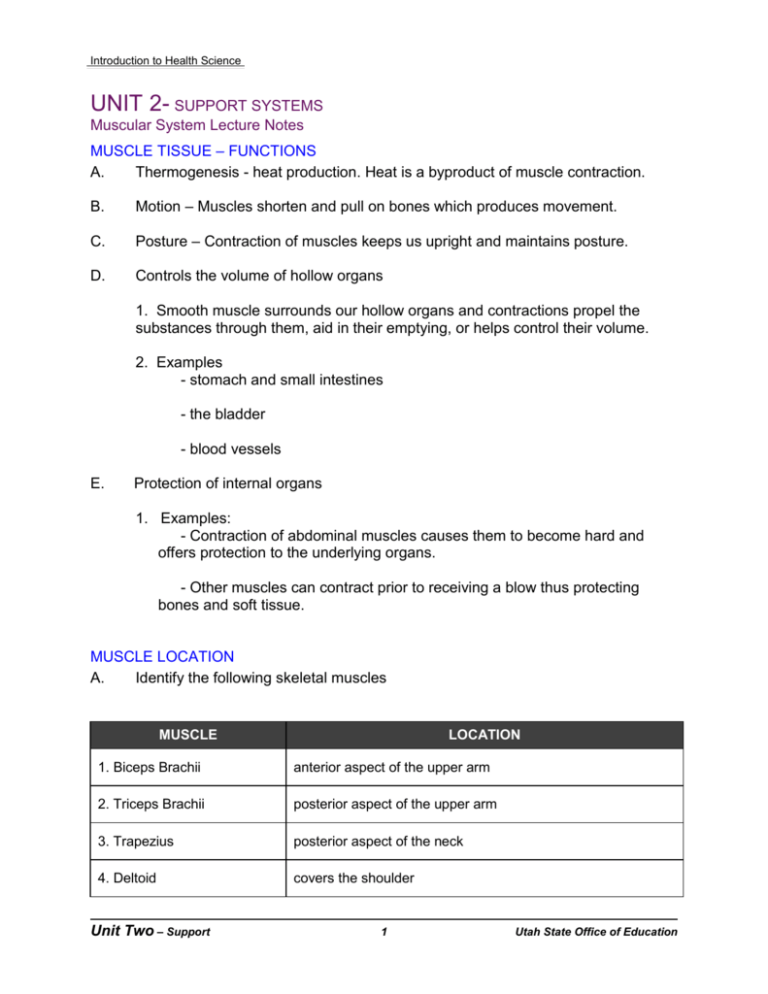Unit 2 Muscular System
advertisement

Introduction to Health Science UNIT 2- SUPPORT SYSTEMS Muscular System Lecture Notes MUSCLE TISSUE – FUNCTIONS A. Thermogenesis - heat production. Heat is a byproduct of muscle contraction. B. Motion – Muscles shorten and pull on bones which produces movement. C. Posture – Contraction of muscles keeps us upright and maintains posture. D. Controls the volume of hollow organs 1. Smooth muscle surrounds our hollow organs and contractions propel the substances through them, aid in their emptying, or helps control their volume. 2. Examples - stomach and small intestines - the bladder - blood vessels E. Protection of internal organs 1. Examples: - Contraction of abdominal muscles causes them to become hard and offers protection to the underlying organs. - Other muscles can contract prior to receiving a blow thus protecting bones and soft tissue. MUSCLE LOCATION A. Identify the following skeletal muscles MUSCLE LOCATION 1. Biceps Brachii anterior aspect of the upper arm 2. Triceps Brachii posterior aspect of the upper arm 3. Trapezius posterior aspect of the neck 4. Deltoid covers the shoulder Unit Two – Support 1 Utah State Office of Education Introduction to Health Science 5. Diaphragm internal muscle that separates the thoracic and abdominal cavities. Attached to the back of the rib cage. 6. Pectoralis Major chest 7. Latissimus Dorsi superficial muscle of the thoracic and lumbar region of the back 8. Rectus Abdominus runs vertically along the abdomen 9. Gastrocnemius posterior aspect of the lower leg 10. Hamstring muscle group posterior aspect of the thigh 11. Quadriceps muscle group anterior aspect of the thigh 12. Gluteus Maximus buttocks region CARDIAC, SMOOTH, AND SKELETAL MUSCLE A. Cardiac Muscle 1. Appearance: Striated— appears striped under a microscope. 2. Control: Involuntary—no conscious control 3. Location: Found in the heart B. Smooth Muscle 1. Appearance: No striations—cells do not appear striped under a microscope 2. Control: Involuntary—no conscious control 3. Location: Found around hollow organs (i.e., stomach, bladder, uterus) C. Skeletal Muscle 1. Appearance: Striated—Appears striped under a microscope 2. Control: Voluntary—conscious control 3. Location: Found attached to bones TENDONS A. Tendons: Attach muscles to bones. Unit Two – Support 2 Utah State Office of Education Introduction to Health Science DISEASES AND DISORDERS OFTHE MUSCULAR SYSTEM A. Tendonitis 1. Characterized by inflammation of the tendons due to overuse or age-related changes of the tendon. 2. Common in individuals who begin a new exercise or increase their level of exercise. 3. Treatments includes Rest, Ice, Compression, and Elevation (RICE) B. Strain 1. A tearing of muscle or its attaching tendon. 2. Occurs when a muscle receives a stress that overcomes its strength. a. sudden, quick heavy lifting b. during sports c. while performing work tasks 3. As with sprains, there are 3 types of strains a. a 1st degree occurs when the muscle is stretched causing micro-tears in the muscle fibers b. a 2nd degree sprain occurs when the muscle or tendon is partially torn c. a 3rd degree sprain occurs when the muscle is completely ruptured. 4. Signs & Symptoms include: a. Pain, especially when the muscle is contracting which limits function b. Swelling c. Bruising 5. Treatment includes Rest, Ice, Compression, Elevation Unit Two – Support 3 Utah State Office of Education Introduction to Health Science C. Muscle Spasm 1. An involuntary muscle contraction 2. Also called a “Charlie Horse” or “Muscle Cramp” 3. main causes are electrolyte imbalances, dehydration and fatigue 4. The initial treatment is to put the muscle that has the spasm on stretch a. If spasm persists ice or heat can be used 5. Prevention includes maintaining a proper diet, drinking plenty of water, and proper conditioning a. Sports drinks may be beneficial during exercise to help replace lost sodium due to sweating D. Muscular Dystrophy 1. An inherited disorder in which the muscles are missing a certain protein causing degeneration of muscle tissue. 2. Causes progressive weakness and loss of function of the affected muscles. 3. There is no cure but physical therapy can lessen the severity of the disorder. Unit Two – Support 4 Utah State Office of Education







